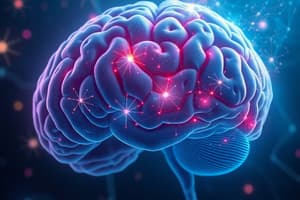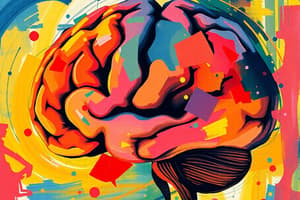Podcast
Questions and Answers
What is the primary function of the Frontal Lobe?
What is the primary function of the Frontal Lobe?
- Movement and reasoning (correct)
- Taste perception
- Visual processing
- Auditory recognition
Which lobe is primarily associated with the perception of sensory stimuli?
Which lobe is primarily associated with the perception of sensory stimuli?
- Parietal Lobe (correct)
- Occipital Lobe
- Frontal Lobe
- Temporal Lobe
What structure primarily houses grey matter nuclei deep within white matter?
What structure primarily houses grey matter nuclei deep within white matter?
- Brain Stem
- Limbic System
- Basal Ganglia (correct)
- Cerebral Cortex
Which statement correctly describes the function of the Occipital Lobe?
Which statement correctly describes the function of the Occipital Lobe?
What type of brain structures are Gyri and Sulci?
What type of brain structures are Gyri and Sulci?
What is the primary role of the cerebellum?
What is the primary role of the cerebellum?
Which structure is located directly below the cerebral cortex?
Which structure is located directly below the cerebral cortex?
What condition is characterized by an abnormal buildup of fluid in the ventricles?
What condition is characterized by an abnormal buildup of fluid in the ventricles?
What is one of the primary functions of the nervous system?
What is one of the primary functions of the nervous system?
Which part of the brain is situated between the right and left halves of the thalamus?
Which part of the brain is situated between the right and left halves of the thalamus?
Which statement correctly describes the organization of the nervous system?
Which statement correctly describes the organization of the nervous system?
What is the primary function of the spinal cord?
What is the primary function of the spinal cord?
Which membranes cover the brain and spinal cord?
Which membranes cover the brain and spinal cord?
Which part of the brain is responsible for higher cognitive functions such as reasoning and planning?
Which part of the brain is responsible for higher cognitive functions such as reasoning and planning?
What is the outermost of the meninges called?
What is the outermost of the meninges called?
What is the role of sensory neurons in the somatic nervous system?
What is the role of sensory neurons in the somatic nervous system?
Which structure acts as the main communication highway between the two hemispheres of the brain?
Which structure acts as the main communication highway between the two hemispheres of the brain?
The basal ganglia are located beneath which part of the brain?
The basal ganglia are located beneath which part of the brain?
Which type of neuron is responsible for carrying information away from the central nervous system?
Which type of neuron is responsible for carrying information away from the central nervous system?
Which of the following is NOT a protective structure of the brain and spinal cord?
Which of the following is NOT a protective structure of the brain and spinal cord?
What characterizes the average number of synapses formed by each neuron in the human brain?
What characterizes the average number of synapses formed by each neuron in the human brain?
Flashcards
Gyri
Gyri
Ridges or hills on the surface of the brain, increasing surface area.
Fissures and Sulci
Fissures and Sulci
Valleys or troughs on the surface of the brain, often separating lobes.
Longitudinal Fissure
Longitudinal Fissure
The deep groove that divides the brain into two hemispheres.
Central Sulcus
Central Sulcus
Signup and view all the flashcards
Lobes of the Cerebrum
Lobes of the Cerebrum
Signup and view all the flashcards
What are the Basal Ganglia?
What are the Basal Ganglia?
Signup and view all the flashcards
What is the Diencephalon?
What is the Diencephalon?
Signup and view all the flashcards
What is the brainstem?
What is the brainstem?
Signup and view all the flashcards
What is the cerebellum?
What is the cerebellum?
Signup and view all the flashcards
What are the ventricles?
What are the ventricles?
Signup and view all the flashcards
What is Hydrocephalus?
What is Hydrocephalus?
Signup and view all the flashcards
What is the spinal cord?
What is the spinal cord?
Signup and view all the flashcards
What are the meninges?
What are the meninges?
Signup and view all the flashcards
What is the function of the nervous system?
What is the function of the nervous system?
Signup and view all the flashcards
What are the parts of the nervous system?
What are the parts of the nervous system?
Signup and view all the flashcards
What is the brain's role in the nervous system?
What is the brain's role in the nervous system?
Signup and view all the flashcards
What is the cerebral cortex?
What is the cerebral cortex?
Signup and view all the flashcards
What is the role of the spinal cord?
What is the role of the spinal cord?
Signup and view all the flashcards
What is the somatic nervous system?
What is the somatic nervous system?
Signup and view all the flashcards
What is the autonomic nervous system?
What is the autonomic nervous system?
Signup and view all the flashcards
What protects the brain and spinal cord?
What protects the brain and spinal cord?
Signup and view all the flashcards
Study Notes
Nervous System Overview
- The nervous system is responsible for controlling the body's internal environment (homeostasis), experiencing and interpreting sensations, controlling voluntary movements and mediating automatic reactions, and perceptions, behaviors and memories.
Intended Learning Outcomes
- Describe the functions of the nervous system
- Describe the organization of the nervous system
- Identify major parts of the brain
- Describe the gross anatomical features of the spinal cord
- Describe protective structures of the brain and spinal cord
Functions of the Nervous System
- Controls the body's internal environment to maintain homeostasis
- Allows for the experience and interpretation of a range of sensations
- Controls all voluntary movements and mediates automatic reactions
- Is responsible for perceptions, behaviors, and memories
Nervous System Organization
- Nervous system is divided into central nervous system (CNS) and peripheral nervous system (PNS)
- CNS: brain and spinal cord
- PNS: includes:
-
autonomic nervous system - communicates with internal organs and glands
- sympathetic division (arousing)
- parasympathetic division (calming)
-
somatic nervous system - communicates with sense organs and voluntary muscles
-
sensory (afferent) nervous system - carries sensory input
-
motor (efferent) nervous system - carries motor output
-
Peripheral Nervous System (Somatic Nervous System)
- Somatic nervous system consists of somatic and special sense receptors
- Sensory neurons carry impulses from receptors to the CNS
- Motor neurons carry impulses from the CNS to skeletal muscles
Afferent Neurons—Sensory—
- Carry information from sensory receptors to the CNS (either cranial or spinal nerves)
Integrative Neurons—Interneurons—
- Integrate and analyze sensory information and decide on an action
Efferent Neurons—Motor—
- Carry information from the brain or spinal cord to muscles or glands (either cranial or spinal nerves)
Effectors (Muscles & Glands)
- Carry out the action initiated by the motor command
The Central Nervous System
- The human brain is the most complex organ in the body
- Contains approximately 86 billion neurons and 10-50 trillion neuroglia
- Each neuron typically forms about 1,000 synapses with other neurons
Major Parts of the Brain
- Cerebrum: includes the outer cerebral cortex, internal region of cerebral white matter, and basal ganglia
- Diencephalon (Thalamus): Located in the middle of the brain, beneath the cerebral cortex and above the midbrain, involved in sensory relay and other functions
- Brainstem (Midbrain, Pons, Medulla Oblongata): Continuous with the spinal cord, controlling vital functions
- Cerebellum: Found just below the cerebrum and behind the pons, involved in motor coordination and learning
Protective Structures (Meninges)
- Meninges are three layers covering the brain and spinal cord
- Outermost: Dura Mater
- Middle: Arachnoid
- Innermost: Pia Mater
Ventricles
- Cavities within the brain filled with cerebrospinal fluid (CSF)
- Lateral ventricles project forward into hemispheres, the third ventricle lies between the right and left halves of the thalamus, and the fourth ventricle lies between the brainstem and the cerebellum
Clinical Application: Hydrocephalus
- Abnormal build-up of fluid in the ventricles
- In infants, blockage of cerebral aqueduct can cause widening of ventricles, putting pressure on brain tissues causing brain damage or death.
Spinal Cord
- Carries incoming and outgoing messages between the brain and the rest of the body
- Contains 100 million neurons and supporting neuroglia
- Extends from the brainstem to the second lumbar vertebra
Further Reading
- Tortora's principles of anatomy and physiology (Chapters 13 & 14)
Studying That Suits You
Use AI to generate personalized quizzes and flashcards to suit your learning preferences.




